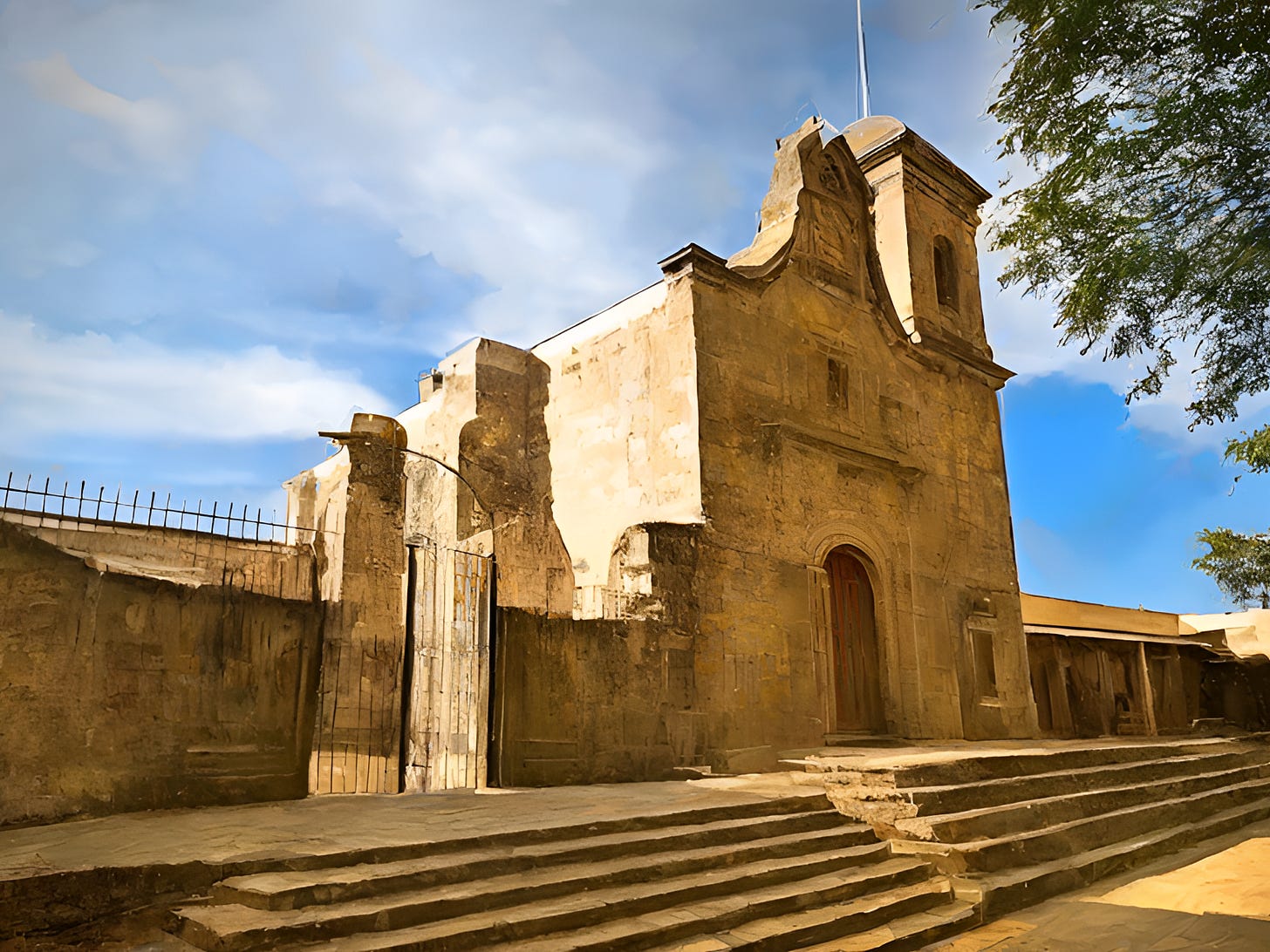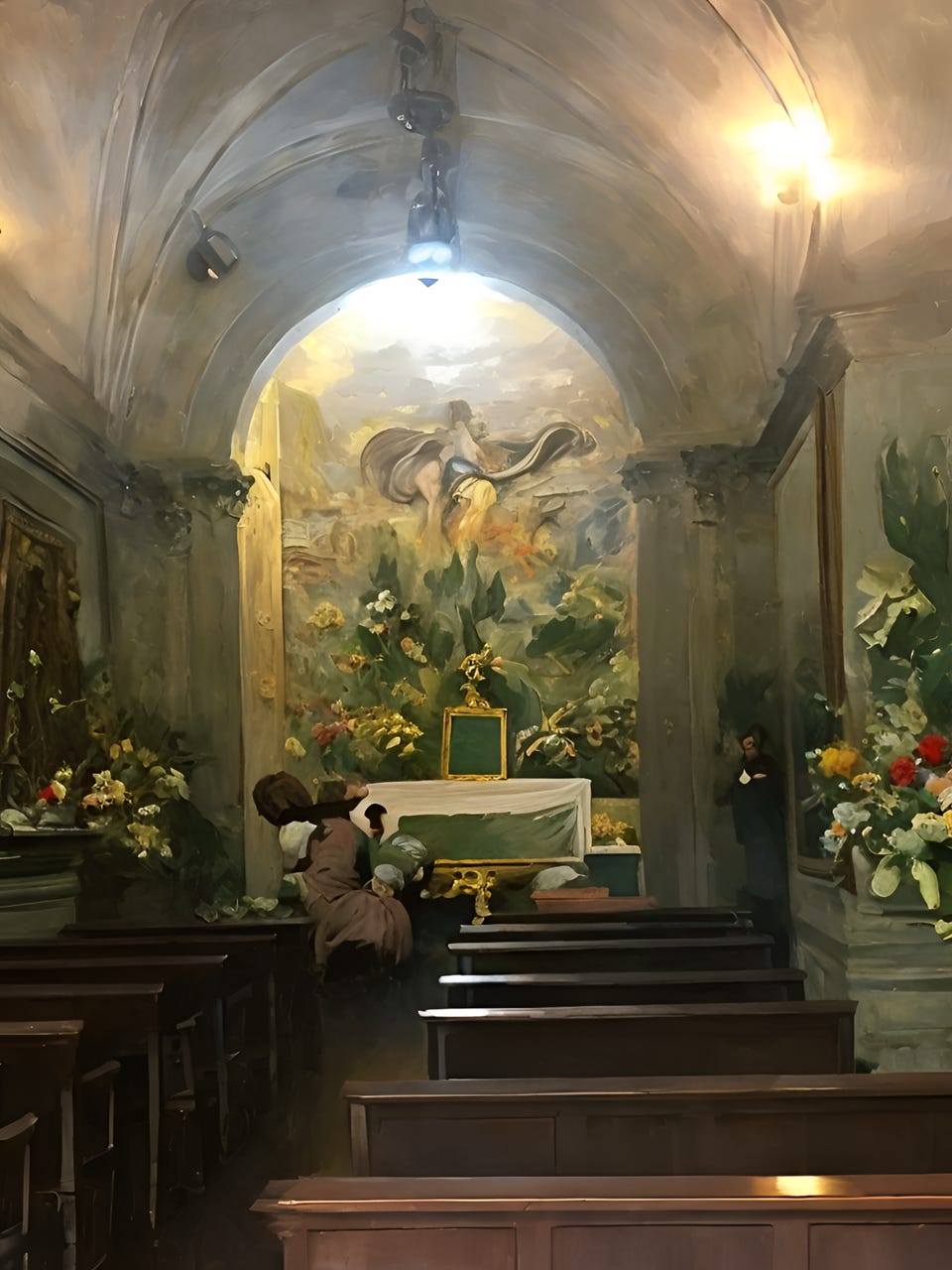Around the church stood several large trees which had been there long before the first stone was laid in the 18th century. Through the immense patchwork canopy, bits of light broke through, illuminating the steps which had trapped rice and confetti from the previous celebration.
We sat for a while on what remained of the original perimeter fence, watching vendors arrive. They trickled in at first, but then as many more arrived, peering out at their bright colored umbrellas suddenly took on the quality of looking through mosaic jelly. As the hour approached, the local mutt had found the way, running circles around the pressed-earth plaza as it scouted for the best possible vantage to scavenge from.
Even though the television had predicted record breaking temperatures, it was comfortable enough even in our heavy suits. Perhaps we had exaggerated the effect of the heat to ourselves, in preperation. More likely, the weatherman was simply wrong, or maybe he had been foiled by a sudden change in the atmosphere. It was turning out to be a wonderful day, either way.
I got up, bored after the stray completed its fourth lap and pulled at my grandfather’s sleeve, urging him to come with me and inspect the few vendors who were already up and running. I feigned interest at most of the common treats; the esquites, raspados, elotes and duritos. Not until I saw the man with the characteristic metal utensil did my stomach rumble.
“Papá, can I have one?”
“Yes, but only if you give me a bite.”
The man behind the cart wasted no time. He dipped the buñuelo mold deep into the oil, then into the bin with the thin batter, then back again into the oil. Around the curiously shaped head, the mixture bloomed into a large golden flower. In seconds, it was done and tossed onto a tray lined with yesterday’s newspaper. Before the grease had all drained off, it was buried under cinammon and sugar.
“Dulce, sir?” The older man behind the cart asked gruffly.
“Only a little, please.” I answered before my grandfather had the chance to say no.
He nudged the cart with his hips as he reached for the syrup. The legs of the rickity cart shook and the bubbling fat, opaque like a vat full of mercury, swayed dangerously. He handed me the pastry in a napkin and we went back to where we were sitting before. My grandfather looked at me and, as promised, I lifted it to his face. He took a greedy portion.
“This is delicious. Don’t tell your Mamá though, she’ll kill us both if she knew what you ate for lunch.” I nodded and finished it soon, lest he ask for another bite.
At the edge of my field of vision, far down the path that led to the grounds of the church, I could see the first of our family to arrive. Though it was no use to try and make out their faces, I could tell it was my aunt, Gloria, and her three daughters. Behind them already were many more people, stepping out of cars, adjusting the skirts of their dresses, putting on their coats, pointing towards the church. From the sidewalk rose waves of heat that licked at the sillhouettes until only the wagging impression of geometry was left. My grandfather directed those who arrived first into the church while I stood behind him, watching close family and complete strangers both disappear into the church. After several awkward encounters with the groom’s family, I made it inside to find my place.
The Parish Church of Our Lord of the Ascension was built at a time when Huentitán was known more for the quality of its stone than for its famous musicians. The walls, the color of drained honeycomb, were from the same cantera dorada that built the Palace of the Governor and the other iconic neo-gothic buildings which are often featured on postcards and government seals. It would take two centuries after Guadalajara’s famous cathedral was built by the hands of Huentitán’s illustrious stone-carvers, for the village which raised them to finally receive its own church of note.
Despite the luxurious skill of its architects and artists, the church was too far from the absolutist fantasies of France and Germany for the elaborate rocaille and coquillage of the altar to seem noble and dignified. Instead, the place of our communion wore the scar of the rococo plainly. Only the crucifix had escaped the ruinous taste for sumptuous curves. The edges of sinew on the arms and legs were sharply defined from beneath the polished wood flesh. Thick red ochre had been applied at the knees and at the points of the thorned crown, dripping like seal wax from the face to the protruding ribs.
From the pews we could see that the spirit of the Lord did not reside in this cherished centerpiece. There was the sin of mankind, sagging on the cross; it would not rise to heaven, not even on the levity of the girlish designs. Only when the priest emerged from the side door of the sacristy in the sublime, lace-trimmed alb reserved for nuptial masses, did the scheme make sense.
Beside him was my uncle, his mustache cropped and hair oiled, the darting pupils of his eyes visible from as far as the seventh row. When the ushers went to remove the showy white cordon reserving the front row, we knew to rise. At the portal, was the first couple. Because my aunt had forgone music at my grandmother’s suggestion, their pace was inconsistent. [1] In the front row I could see my grandmother’s angry face as she watched their steps too-quickly approach her. It had not been noticed by anyone else. The handsome young couple, the most recently married, drew sighs in their matching suits. They made the sign of the cross over themselves and went to their respective sides.
The next couple came slowly, their arms crossed together, steps synchronized to the wedding march they had practiced.
I had never before seen my mother in traditional clothing. Her suit matched mine, the same white cording and shade of golden ribbon. Her hair was done high in an impressive bouffant, held in place by a citrine clip in the shape of a bee. On her arm was the handsome brother of my uncle, the tips of his ears red with embarrassment. They took small, syncopated steps, taking care to stay next to one another. She smiled and winked at me as she passed by, the stream of Samsara roaring and then tapering in my nose as she moved further away.
From the blinding light of the narthex my aunt emerged, her hand in my grandfather’s. The beadwork of the cathedral veil threw eye-wrenching bits of color against the arch. All throughout the previous day, she had sewn small silk flowers onto the diadem which kept it in palce. In the cloying yellow light of our living room, on the pink upholstery, they ruined the modern aspirations of the dress. It was an inelegant addition which my mother had protested against. But, in that silly church with its pretentious scrolls, under the veil which wisped and flapped in and out of existence, the diadem was like a single asphodel which stood out in the bog of white georgette.
She glid past the abuelitas and gossping aunts who had fortold of disaster, keeping her chin gently turned downwards, fixed like a constellation to the muscular bouquet of stargazer lilies and white dahlias.
Muffled gasps came when, at the sight of the husband’s earnest tears, my grandfather too began to cry. He was not my aunt’s biological father, he never had children, or grandchildren, of his own. He was clearly thinking to his own wedding day. To the day he married the town’s young widow and adopted her two daughters. It had happened in this same church, the modest reception which had no dress and no costume. The grey serge sports coat he wore had been the same one from the photograph of his wedding day. It’s sleeves had been rehemmed myriad times, the lining had been discarded and replaced, the démodé kerchief left at home.
He reluctantly let go of his youngest in front of the altar, put his forehead to hers, looked at my grandmother pleadingly and took the first step apart. The couple met in the aisle and took a seat on the modified sedan chair.






Great🫶